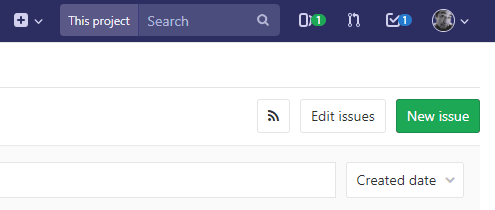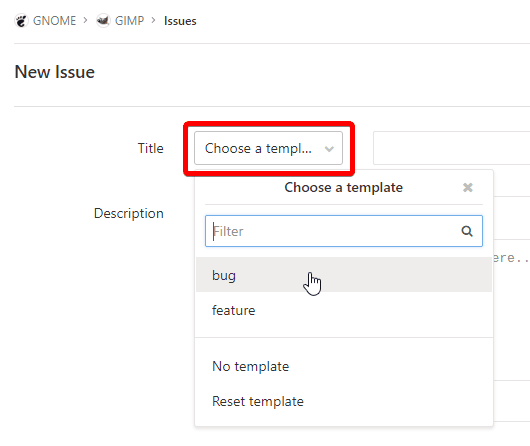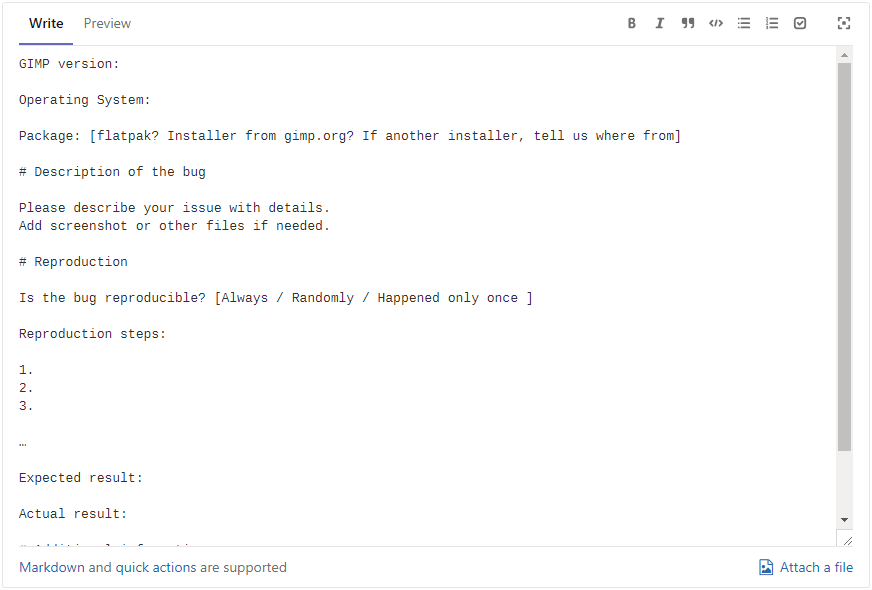GIMP
News
Docs
Tutorials
More
Making good bug reports is a great way to help increase the software quality of GIMP. A good bug report provides:
This makes it easy for the developers to reproduce and fix the bug.
Related to bug reports are enhancement requests. It is recommended to discuss enhancements with developers first, for instance on IRC or in the forums. This is to make sure that the enhancement requests that are filed are well-specified and aligned with the overall goals the developers have for GIMP.
The goal is to give the developers as much information as possible to help them understand what needs to be fixed:
Use gimp --version or the about dialog (Help → About GIMP) to check your
GIMP version. Next compare to the most recent GIMP release on
www.gimp.org. If your GIMP is old, update and try
to reproduce the bug. Your bug may have been fixed in a recent release.
Attempt to reproduce the problem. Go do what you were doing when it happened and see if you can trigger the bug again.
If you know how to do so, start the program from a terminal, or you can follow the instructions. Sometimes it will output helpful error messages. After reproducing the bug, copy the error messages from your terminal so you can paste them in the bug report. It is better to give too much information than not enough.
To narrow down the exact cause of the problem, attempt to reproduce it in other ways. Prepare yourself to explain how to reproduce it in your bug report. If you are running GIMP in another language, try switching GIMP to English so you can report menu items exactly with the English menu item name. It simplifies developers’ task.
If you cannot reproduce the bug and don’t have any reliable information, reporting might be fruitless and only waste everyone’s time. If it recurs, consult with appropriate discussion channels. Perhaps someone else can find the key to reproducing it.
Go to GIMP issues. If you don’t have a login yet, follow the directions to create one.
Select “New issue”.

Choose a template to pre-populate the Description field with important information to help the developers track down the problem:

Give your bug a good Title and if you chose a template you should see some text in the Description field already.
Here in the Description you’ll have to tell the developers everything about your system, your version of GIMP, and your bug. Just do your best to tell them about it. A crappy bug report is better than no report at all, but if you write down everything clearly you’ll be going a long way to helping get the bug addressed.

Remember, try to be as clear and concise as possible! This is immensely helpful in tracking down what the problem is and how to possibly fix it.
Finally, please add the output you get from running gimp --version
--verbose to your bug report, and publish the report by clicking the blue
“Create issue” button.
You should not expect immediate responses as contributors have a lot of tasks, though they try to be reactive when possible. They may ask you for more information and will tell you what to do to get it (you should get email notifications). We don’t expect you to do answer immediately as well, though we expect you to follow up eventually.
If you later get more information (like a more specific error message or fancy stuff like a trace), add a comment to your original bug with that information.
It is especially important to add a comment if you somehow resolve your bug. For example, you update something else on your system and the bug no longer appears. In that case, add a comment describing what you updated from what version to what version. This helps everyone and saves a lot of time which can be used to fix other bugs or implement nice features.
Whee!! You survived! If you managed to get through all this and submit your bug report, be happy. Be proud as a contributor to the community!
You will later get e-mails about your bug. It may not be immediate. Since GIMP is developed by a community, by volunteers, sometimes it may take some time. Though we try to always answer. Similarly when we ask you questions, we don’t expect you to answer immediately, though we expect you to answer eventually. Otherwise it makes no sense. The basis is that we acknowledge that everyone has a life outside of GIMP, you as much as the developers.
Answers might include a request for more information. If you get something that says your bug is not a bug, was already fixed or is a duplicate to another report, do not be discouraged from reporting in the future. Next time it might be. Submitting careful bug reports and providing additional information where possible helps make GIMP better. The day will come where you submit a bug and later get an e-mail that says your bug is “FIXED” or “RESOLVED”. Then you will know that some developer out there found your bug, reproduced it, and fixed it. 🎉
Some bug reports may be related to security issues. For example, a file plug-in may be vulnerable to a buffer overflow allowing arbitrary code execution when loading an image.
We believe that the best way to report these vulnerabilities is still through our GitLab issues, as described above. This will ensure that the bug is reviewed and handled quickly. The only difference is that you will need to choose the proper security report template and check the box “This issue is confidential and should only be visible to team members with at least Reporter access.” in the GitLab issue creation form (this checkbox will hide the bug report from anyone else but core members).
But if you really do not want to use GitLab for security reports and you do not
mind some extra delay, you can also contact a limited set of GIMP developers by mail @gimp.org, using the special alias security. What will happen next is
that a developer will review the issue and submit it in GitLab, usually as a
hidden bug report only visible to developers.
This will take a bit longer than if you directly submit the bug yourself, but we know that some people have a policy of not disclosing security vulnerabilities publicly, so we provide that address for their convenience.